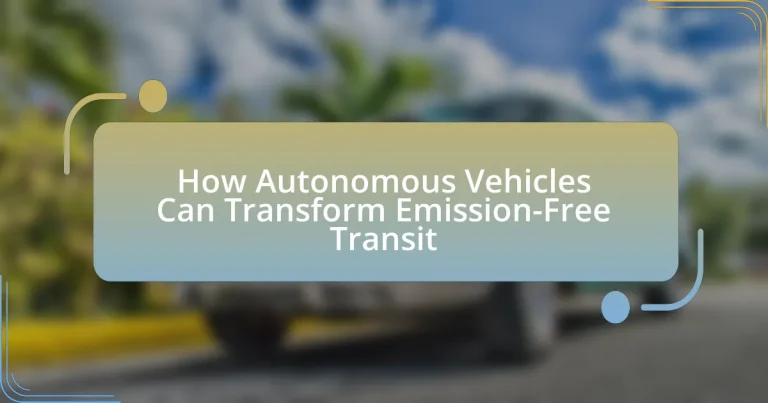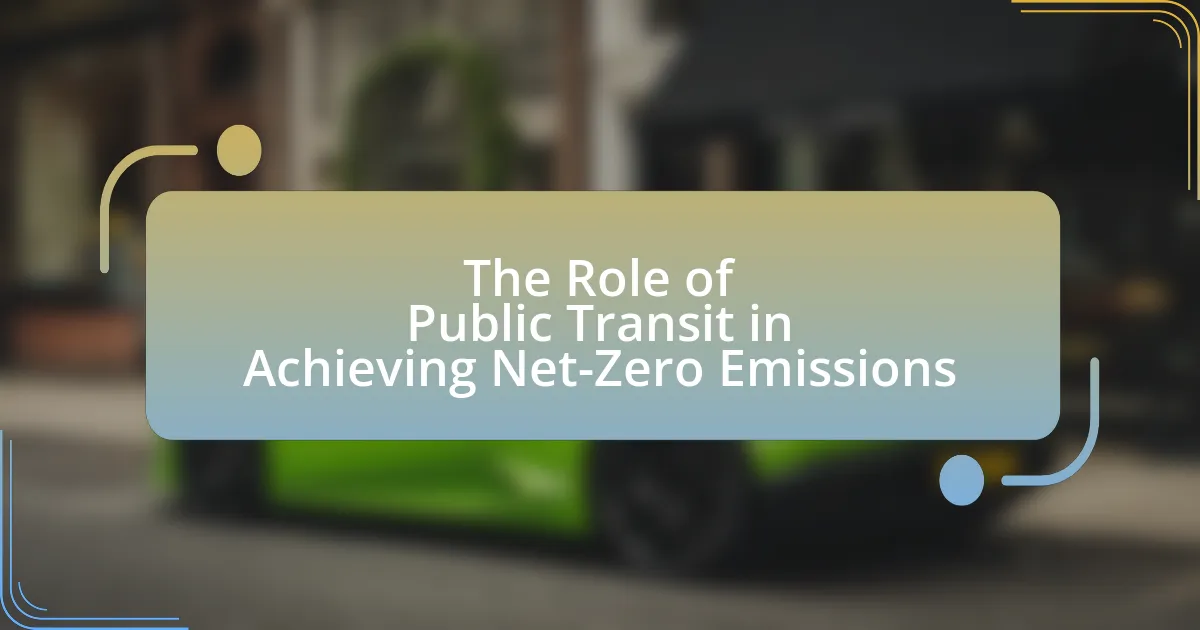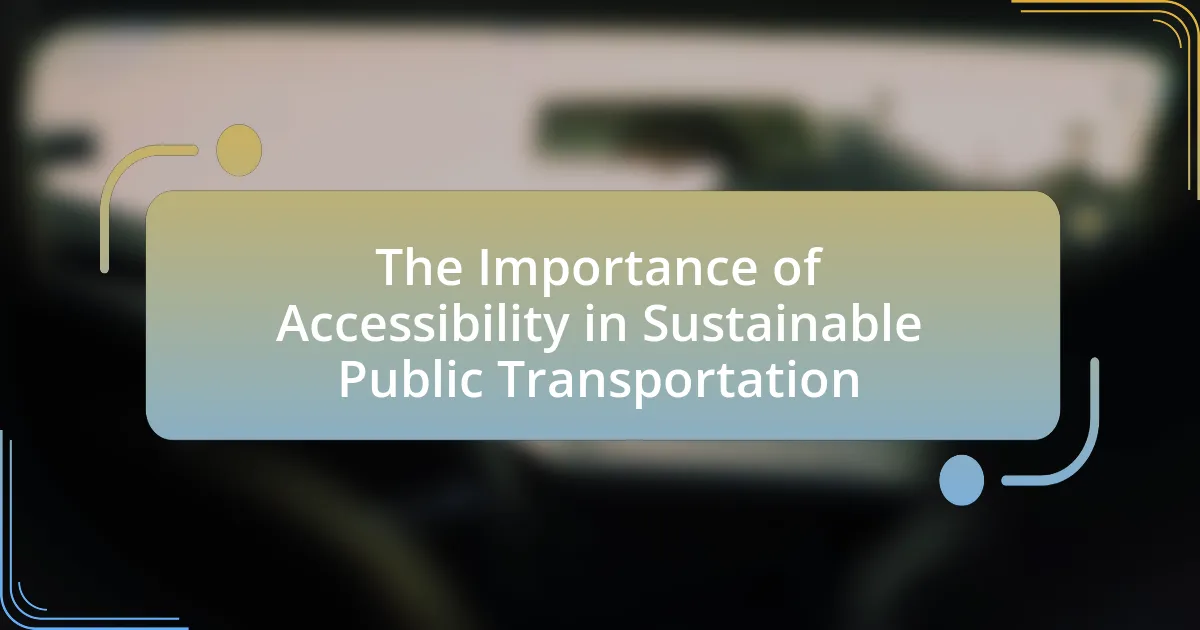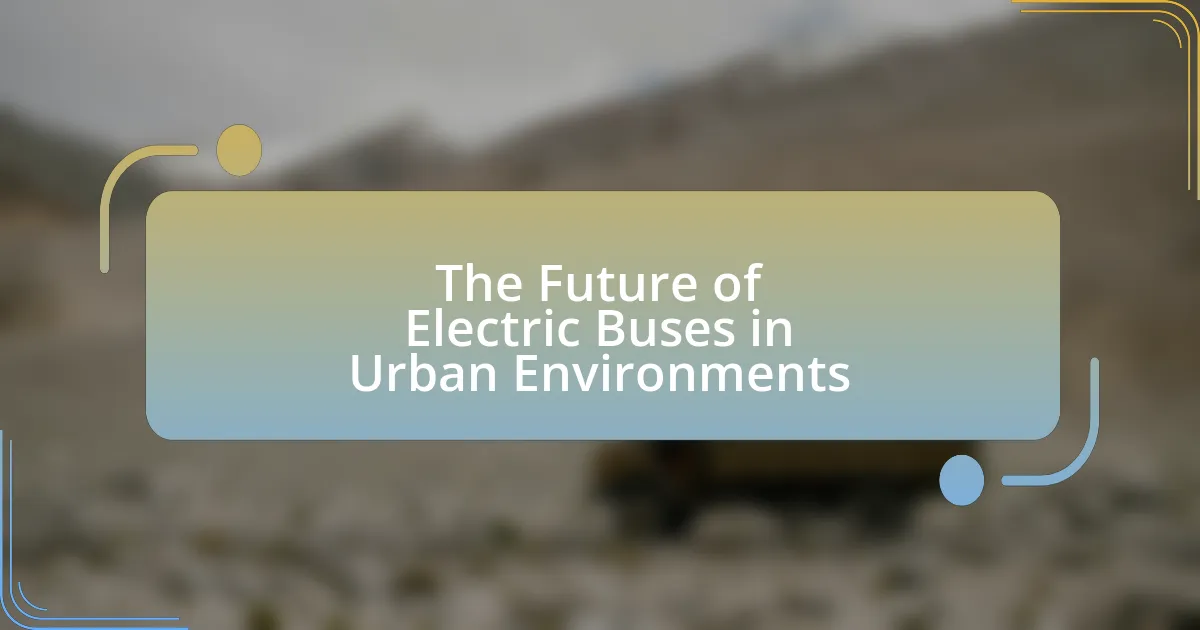Autonomous vehicles represent a significant advancement in the pursuit of emission-free transit, leveraging technologies such as sensors, artificial intelligence, and machine learning to optimize driving patterns and reduce energy consumption. By improving fuel efficiency and integrating with electric powertrains, these vehicles can substantially lower greenhouse gas emissions, contributing to global sustainability goals. The article explores the key technologies enabling autonomous vehicles, the environmental importance of emission-free transit, the challenges faced in achieving this goal, and the potential models for integrating autonomous vehicles into existing public transit systems. Additionally, it addresses the necessary infrastructure changes, regulatory hurdles, and strategies for enhancing public acceptance of autonomous transit solutions.
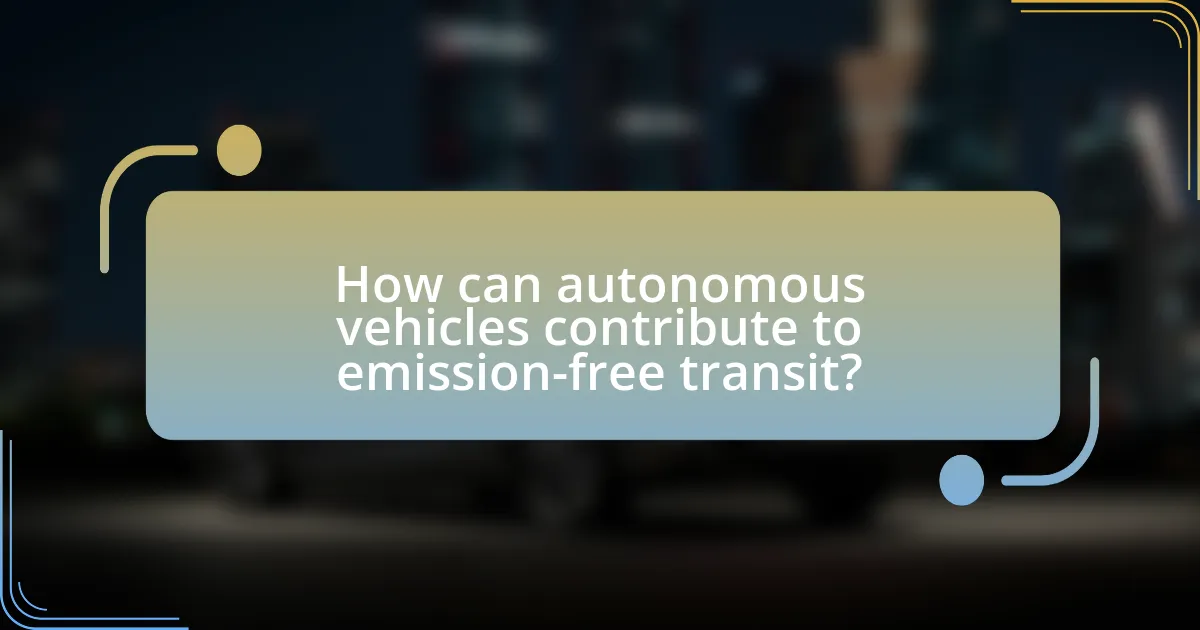
How can autonomous vehicles contribute to emission-free transit?
Autonomous vehicles can contribute to emission-free transit by optimizing driving patterns and reducing energy consumption. These vehicles utilize advanced algorithms and sensors to enhance route efficiency, minimize idling, and maintain optimal speeds, which collectively lead to lower energy usage. For instance, studies indicate that autonomous vehicles can improve fuel efficiency by up to 20% through better traffic management and reduced congestion. Additionally, when paired with electric powertrains, autonomous vehicles can significantly decrease greenhouse gas emissions, aligning with global efforts to achieve sustainable transportation goals.
What are the key technologies behind autonomous vehicles?
The key technologies behind autonomous vehicles include sensors, artificial intelligence, machine learning, and connectivity systems. Sensors such as LiDAR, radar, and cameras enable vehicles to perceive their environment by detecting obstacles, lane markings, and traffic signals. Artificial intelligence processes the data collected by these sensors to make real-time driving decisions. Machine learning algorithms improve the vehicle’s performance over time by learning from vast amounts of driving data. Connectivity systems, including Vehicle-to-Everything (V2X) communication, allow vehicles to interact with each other and infrastructure, enhancing safety and efficiency. These technologies collectively enable autonomous vehicles to navigate complex environments safely and efficiently.
How do sensors and AI work together in autonomous vehicles?
Sensors and AI work together in autonomous vehicles by enabling real-time data collection and intelligent decision-making. Sensors, such as LiDAR, cameras, and radar, gather information about the vehicle’s surroundings, including obstacles, road conditions, and traffic signals. This data is then processed by AI algorithms, which analyze the information to make driving decisions, such as navigation, speed adjustment, and obstacle avoidance. For instance, a study by the National Highway Traffic Safety Administration found that the integration of AI with sensor data can significantly reduce accidents by improving reaction times and situational awareness.
What role does machine learning play in improving autonomous driving?
Machine learning significantly enhances autonomous driving by enabling vehicles to interpret vast amounts of data from their surroundings, improving decision-making and safety. Through algorithms that learn from real-world driving scenarios, machine learning allows vehicles to recognize objects, predict behaviors, and adapt to dynamic environments. For instance, Tesla’s Autopilot system utilizes deep learning to process data from cameras and sensors, achieving over 1 billion miles of data collection, which continuously refines its algorithms for better performance. This data-driven approach not only increases the accuracy of navigation and obstacle detection but also contributes to the overall reliability of autonomous systems, making them safer for public use.
Why is emission-free transit important for the environment?
Emission-free transit is crucial for the environment because it significantly reduces greenhouse gas emissions and air pollutants. Transportation is a major contributor to global carbon dioxide emissions, accounting for approximately 24% of total emissions according to the Intergovernmental Panel on Climate Change. By utilizing emission-free transit options, such as electric or hydrogen-powered vehicles, we can mitigate climate change impacts and improve air quality. Studies show that transitioning to emission-free transportation can lead to a reduction of up to 70% in urban air pollution, thereby enhancing public health and promoting sustainable urban development.
How do traditional vehicles contribute to pollution?
Traditional vehicles contribute to pollution primarily through the emission of greenhouse gases and harmful pollutants from their internal combustion engines. These vehicles release carbon dioxide, nitrogen oxides, and particulate matter, which significantly degrade air quality and contribute to climate change. According to the Environmental Protection Agency (EPA), transportation is responsible for approximately 29% of total greenhouse gas emissions in the United States, with traditional gasoline and diesel vehicles being the largest contributors. This pollution not only affects the environment but also poses serious health risks, leading to respiratory diseases and other health issues in populations exposed to vehicle emissions.
What are the long-term benefits of reducing emissions in urban areas?
Reducing emissions in urban areas leads to improved public health, enhanced environmental quality, and economic benefits. Improved air quality results in fewer respiratory and cardiovascular diseases, which can reduce healthcare costs and increase productivity. For instance, a study by the American Lung Association found that reducing air pollution could prevent thousands of premature deaths annually. Enhanced environmental quality contributes to biodiversity and climate resilience, while economic benefits arise from increased energy efficiency and reduced costs associated with climate change impacts. These long-term advantages underscore the importance of emission reduction strategies in urban planning and policy.
What challenges do autonomous vehicles face in achieving emission-free transit?
Autonomous vehicles face significant challenges in achieving emission-free transit, primarily due to reliance on energy sources and infrastructure limitations. The majority of autonomous vehicles currently operate on electric power, which necessitates a robust charging infrastructure that is not yet universally available. According to the International Energy Agency, as of 2021, only about 1.3 million public charging points existed globally, which is insufficient to support widespread adoption of electric autonomous vehicles. Additionally, the production of batteries for electric vehicles involves mining and processing materials like lithium and cobalt, which can have substantial environmental impacts. Furthermore, the integration of autonomous vehicles into existing transportation systems requires substantial upgrades to urban infrastructure, including smart traffic management systems, which are still in developmental stages in many regions. These factors collectively hinder the transition to emission-free transit for autonomous vehicles.
How do regulatory hurdles impact the deployment of autonomous vehicles?
Regulatory hurdles significantly delay the deployment of autonomous vehicles by imposing strict safety, liability, and operational standards. These regulations often require extensive testing and validation processes, which can take years to complete, thereby slowing down the introduction of autonomous technology to the market. For instance, the National Highway Traffic Safety Administration (NHTSA) has established guidelines that necessitate rigorous safety assessments before autonomous vehicles can be legally operated on public roads. This regulatory framework can lead to increased costs for manufacturers and limit innovation, as companies may prioritize compliance over technological advancement. Consequently, the slow pace of regulatory approval can hinder the potential benefits of autonomous vehicles in transforming emission-free transit by delaying their integration into existing transportation systems.
What technological limitations currently exist for autonomous vehicles?
Technological limitations for autonomous vehicles include challenges in perception, decision-making, and infrastructure compatibility. Current sensors, such as LiDAR and cameras, can struggle with adverse weather conditions like heavy rain or fog, which impacts their ability to accurately detect obstacles. Additionally, autonomous systems often face difficulties in complex environments, such as urban areas with unpredictable pedestrian behavior and intricate traffic patterns. Furthermore, the lack of standardized infrastructure, such as dedicated lanes or communication systems between vehicles and traffic signals, hinders the effectiveness of autonomous navigation. These limitations are supported by studies indicating that approximately 75% of autonomous vehicle incidents occur in complex driving scenarios, highlighting the need for improved technology and infrastructure to enhance safety and reliability.
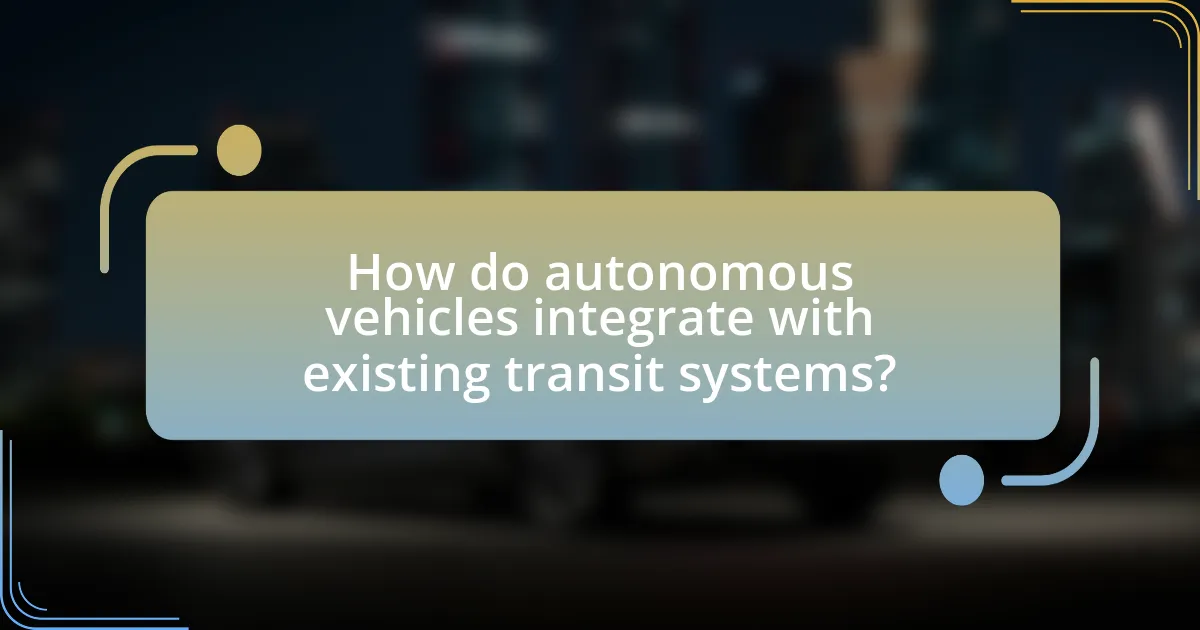
How do autonomous vehicles integrate with existing transit systems?
Autonomous vehicles integrate with existing transit systems by enhancing connectivity and efficiency through technology and data sharing. These vehicles can operate as on-demand shuttles, filling gaps in public transportation networks, and providing first-mile and last-mile solutions that connect users to major transit hubs. For instance, cities like San Francisco and Austin have piloted autonomous shuttle services that complement traditional bus routes, demonstrating a reduction in wait times and increased ridership. Additionally, data from autonomous vehicles can be shared with transit agencies to optimize routes and schedules, improving overall system performance and user experience.
What are the potential models for integrating autonomous vehicles into public transit?
Potential models for integrating autonomous vehicles into public transit include on-demand shuttle services, fixed-route autonomous buses, and first-mile/last-mile solutions. On-demand shuttle services utilize autonomous vehicles to provide flexible, real-time transportation options that adapt to passenger needs, enhancing accessibility and efficiency. Fixed-route autonomous buses operate on predetermined paths, offering reliable service while reducing operational costs and improving safety through advanced technology. First-mile/last-mile solutions connect passengers from their homes to transit hubs, facilitating seamless integration with existing public transit systems. These models can significantly reduce emissions and improve urban mobility, as evidenced by pilot programs in cities like San Francisco and Phoenix, which have demonstrated increased ridership and decreased congestion.
How can autonomous shuttles complement existing bus services?
Autonomous shuttles can complement existing bus services by providing first-mile and last-mile connectivity, enhancing overall public transportation efficiency. These shuttles can operate in areas with lower demand where traditional bus routes may not be economically viable, thus filling service gaps. For instance, a study by the American Public Transportation Association found that integrating autonomous shuttles with existing transit systems can increase ridership by up to 20% in urban areas. This integration allows for seamless transfers between shuttles and buses, improving accessibility and convenience for passengers.
What partnerships are necessary for successful integration?
Successful integration of autonomous vehicles in emission-free transit requires partnerships between technology developers, regulatory bodies, public transportation agencies, and infrastructure providers. Technology developers create the necessary software and hardware for autonomous systems, while regulatory bodies establish the legal framework for their operation. Public transportation agencies facilitate the integration of these vehicles into existing transit systems, ensuring accessibility and efficiency. Infrastructure providers are essential for developing the necessary charging stations and smart road systems that support autonomous operations. These partnerships are critical for addressing safety, efficiency, and public acceptance, ultimately leading to a successful transition to emission-free transit solutions.
How can cities prepare for the adoption of autonomous vehicles?
Cities can prepare for the adoption of autonomous vehicles by investing in infrastructure that supports their operation, such as dedicated lanes, smart traffic signals, and enhanced communication systems. Research indicates that cities implementing these changes can improve traffic flow and safety; for example, a study by the National Highway Traffic Safety Administration found that smart infrastructure can reduce accidents by up to 30%. Additionally, cities should develop regulatory frameworks that address liability, insurance, and data privacy concerns associated with autonomous vehicles, ensuring a clear legal landscape for their integration. By proactively addressing these areas, cities can facilitate a smoother transition to autonomous vehicle technology, ultimately contributing to emission-free transit solutions.
What infrastructure changes are needed to support autonomous transit?
To support autonomous transit, significant infrastructure changes are required, including the development of dedicated lanes for autonomous vehicles, enhanced communication networks, and updated traffic management systems. Dedicated lanes ensure safety and efficiency by separating autonomous vehicles from traditional traffic, which reduces the risk of accidents. Enhanced communication networks, such as 5G, facilitate real-time data exchange between vehicles and infrastructure, improving navigation and response times. Updated traffic management systems, incorporating smart traffic signals and sensors, optimize traffic flow and reduce congestion, which is essential for the effective operation of autonomous transit. These changes are supported by studies indicating that dedicated infrastructure can increase the operational efficiency of autonomous vehicles by up to 30%, demonstrating the necessity of these modifications for successful implementation.
How can urban planning adapt to incorporate autonomous vehicles?
Urban planning can adapt to incorporate autonomous vehicles by redesigning infrastructure to support their unique operational needs. This includes creating dedicated lanes for autonomous vehicles, integrating smart traffic management systems that communicate with these vehicles, and rethinking parking solutions to accommodate their drop-off and pick-up capabilities. For instance, cities like San Francisco have begun implementing pilot programs that test autonomous vehicle integration, demonstrating the potential for reduced congestion and improved traffic flow. Additionally, studies indicate that autonomous vehicles can lead to a 20-30% reduction in urban parking demand, allowing for repurposing of space for green areas or pedestrian pathways.

What are the future implications of autonomous vehicles on emission-free transit?
Autonomous vehicles are poised to significantly enhance emission-free transit by optimizing energy efficiency and reducing reliance on fossil fuels. These vehicles can be programmed to operate in a manner that maximizes battery life and minimizes energy consumption, leading to lower overall emissions. For instance, studies indicate that autonomous electric vehicles can reduce energy use by up to 30% through efficient route planning and driving patterns. Furthermore, the integration of autonomous vehicles into public transit systems can facilitate a shift towards shared mobility solutions, decreasing the number of individual vehicles on the road and further lowering emissions. As cities adopt more autonomous electric fleets, the potential for achieving substantial reductions in greenhouse gas emissions becomes increasingly viable, supporting global sustainability goals.
How might consumer behavior change with the rise of autonomous vehicles?
Consumer behavior is likely to shift towards increased reliance on shared mobility services with the rise of autonomous vehicles. As autonomous vehicles become more prevalent, consumers may prioritize convenience and cost-effectiveness over ownership, leading to a decline in personal vehicle purchases. Research indicates that 60% of consumers are open to using ride-sharing services instead of owning a car, particularly in urban areas where autonomous vehicles can reduce traffic congestion and parking needs. This shift could also result in changes in consumer preferences for vehicle features, emphasizing safety and technology over traditional performance metrics.
What impact will autonomous vehicles have on car ownership trends?
Autonomous vehicles are expected to significantly reduce car ownership trends. As these vehicles become more prevalent, individuals may opt for shared mobility services instead of owning personal cars, leading to a decrease in the overall number of vehicles owned. A study by the International Transport Forum indicates that widespread adoption of autonomous vehicles could reduce car ownership by up to 80% in urban areas, as people will rely on on-demand transportation services rather than maintaining personal vehicles. This shift not only reflects changing consumer preferences but also aligns with urban planning goals aimed at reducing congestion and emissions.
How could public perception of autonomous vehicles evolve over time?
Public perception of autonomous vehicles could evolve positively over time as technological advancements and successful implementations increase trust and acceptance. Initially, skepticism and fear regarding safety and reliability dominate public sentiment, as evidenced by early studies showing that 70% of people expressed concerns about self-driving technology. However, as autonomous vehicles demonstrate consistent safety records, reduce traffic accidents, and provide convenience, public confidence is likely to grow. For instance, a 2021 survey indicated that 60% of respondents would feel more comfortable using autonomous vehicles if they were proven to be safer than human drivers. Additionally, increased exposure through pilot programs and media coverage can further shift perceptions, leading to a gradual acceptance of autonomous vehicles as a viable and beneficial mode of transportation.
What are the best practices for promoting emission-free transit through autonomous vehicles?
The best practices for promoting emission-free transit through autonomous vehicles include integrating electric vehicle technology, optimizing route planning, and implementing supportive policies. Integrating electric vehicle technology ensures that autonomous vehicles operate without emissions, as electric vehicles produce zero tailpipe emissions. Optimizing route planning through advanced algorithms reduces energy consumption and enhances efficiency, leading to lower overall emissions. Implementing supportive policies, such as incentives for electric autonomous vehicle adoption and investments in charging infrastructure, encourages the transition to emission-free transit. These practices collectively contribute to a sustainable transportation ecosystem, as evidenced by studies showing that electric autonomous vehicles can significantly reduce greenhouse gas emissions compared to traditional fossil fuel-powered vehicles.
How can stakeholders collaborate to enhance public acceptance of autonomous transit?
Stakeholders can collaborate to enhance public acceptance of autonomous transit by engaging in transparent communication, conducting public education campaigns, and involving community feedback in the development process. Transparent communication builds trust, as stakeholders such as government agencies, transit authorities, and technology companies can share information about safety measures, operational protocols, and benefits of autonomous transit. Public education campaigns can demystify autonomous technology, highlighting its potential to reduce traffic congestion and emissions, which aligns with the goals of emission-free transit. Additionally, actively seeking community feedback through surveys and public forums allows stakeholders to address concerns and adapt services to meet public needs, fostering a sense of ownership and acceptance. Research indicates that community involvement in transportation planning significantly increases public support for new transit initiatives, demonstrating the effectiveness of these collaborative strategies.
What strategies can be employed to educate the public about the benefits of autonomous vehicles?
To educate the public about the benefits of autonomous vehicles, targeted awareness campaigns utilizing social media, community workshops, and partnerships with educational institutions can be employed. These strategies can effectively disseminate information about safety, efficiency, and environmental benefits associated with autonomous vehicles. For instance, studies show that public perception improves significantly when individuals are exposed to educational materials that highlight the reduction in traffic accidents by up to 90% due to advanced safety features in autonomous vehicles. Additionally, interactive demonstrations and pilot programs can provide firsthand experience, further reinforcing the advantages of this technology.
